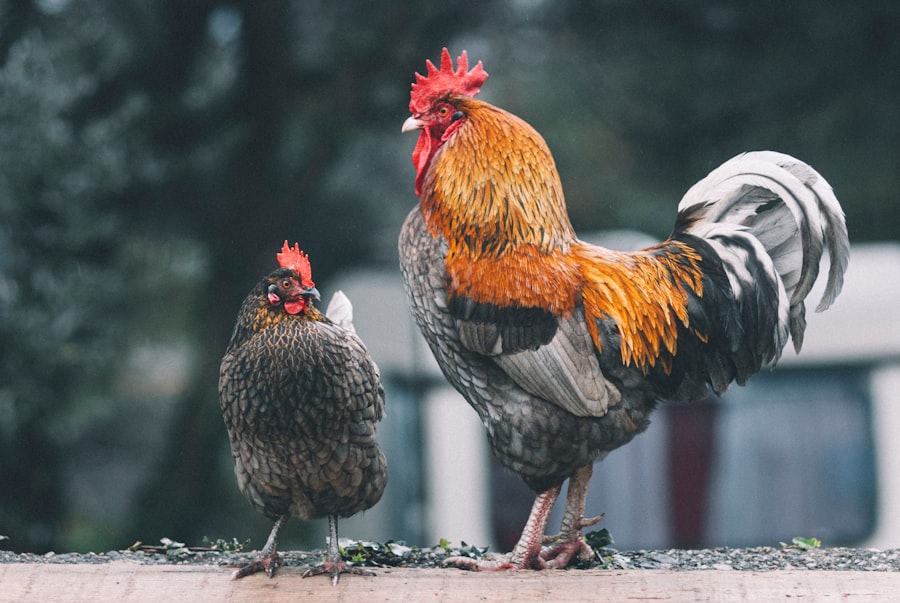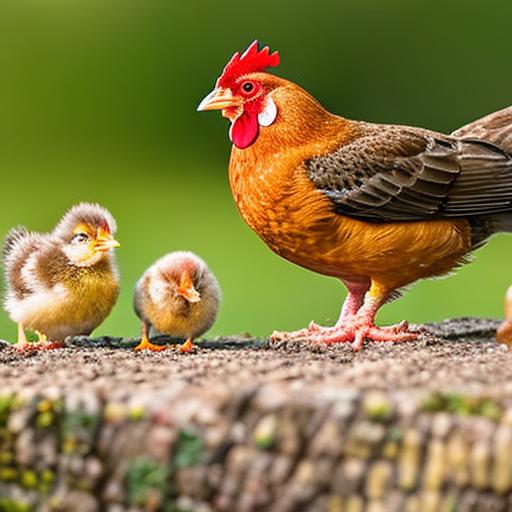Raising chickens in South Bend, Indiana has become increasingly popular in recent years. Many people are drawn to the idea of having a sustainable source of fresh eggs, as well as the opportunity to connect with nature and have a rewarding hobby. However, before diving into the world of chicken keeping, it is important to understand the basics and ensure that you are well-prepared for the responsibilities that come with it.
One of the main benefits of raising chickens in South Bend is the access to fresh, organic eggs. Chickens are excellent egg producers and can provide you with a steady supply of nutritious eggs for your family. In addition, raising chickens can also be a great educational experience for children, teaching them about responsibility, animal care, and where their food comes from.
Before getting started, it is crucial to have a good understanding of the basics of chicken keeping. This includes knowing how to properly care for chickens, providing them with a safe and comfortable environment, and understanding their nutritional needs. By doing your research and being well-prepared, you can ensure that your chickens thrive and that you have a successful experience raising them.
Key Takeaways
- Check your city’s ordinances before raising chickens in South Bend
- Consider factors such as size, ventilation, and predator protection when choosing a chicken coop
- Building your own chicken coop can be a cost-effective option
- Buying a pre-made chicken coop can save time and effort, but may be more expensive
- Proper maintenance and feeding are crucial for keeping chickens healthy and happy
Legal Considerations: Checking Your City’s Ordinances on Keeping Chickens
Before bringing chickens into your backyard in South Bend, it is important to research and understand the local laws and regulations regarding keeping chickens. Each city may have its own ordinances that dictate the number of chickens allowed, any restrictions on coop placement, and other requirements.
Start by checking with your local city government or zoning department to find out if there are any specific regulations or permits required for keeping chickens. Some cities may have restrictions on the number of chickens allowed based on lot size or proximity to neighboring properties. It is important to know these regulations before getting started to avoid any potential legal issues.
In addition to the number of chickens allowed, you should also consider any restrictions on coop placement. Some cities may require a certain distance between the coop and neighboring properties or have specific guidelines for coop design and construction. By understanding these regulations, you can ensure that you are in compliance and provide a safe and comfortable environment for your chickens.
Choosing the Right Chicken Coop: Factors to Consider
One of the most important aspects of raising chickens is providing them with a suitable coop. The coop serves as their shelter, protection from predators, and a place for them to lay their eggs. When choosing a chicken coop, there are several factors to consider.
First, consider the size and design of the coop. The size of the coop will depend on the number of chickens you plan to keep. It is important to provide enough space for each chicken to move around comfortably and have access to nesting boxes and perches. The design of the coop should also take into consideration ventilation, natural light, and ease of access for cleaning and maintenance.
Another factor to consider is the materials used for construction. Chicken coops can be made from a variety of materials, including wood, metal, or plastic. Wood is a popular choice due to its durability and natural insulation properties. However, it is important to choose rot-resistant wood and treat it with non-toxic sealants to ensure longevity.
Accessibility for cleaning and maintenance is also an important factor to consider when choosing a chicken coop. The coop should have easy access to clean out droppings, replace bedding, and collect eggs. It should also be designed in a way that allows for easy cleaning and disinfection to prevent the spread of diseases.
Building Your Own Chicken Coop: A Step-by-Step Guide
If you are handy with tools and enjoy do-it-yourself projects, building your own chicken coop can be a rewarding experience. Not only can you customize the coop to fit your specific needs, but it can also be a more cost-effective option compared to buying a pre-made coop. Here is a step-by-step guide to building a basic chicken coop:
1. Plan and design your coop: Start by determining the size of the coop based on the number of chickens you plan to keep. Sketch out a design that includes nesting boxes, perches, and access doors. Consider ventilation and natural light in your design.
2. Gather materials: Purchase the necessary materials for construction, including lumber, hardware, wire mesh, roofing materials, and any other supplies needed for your specific design.
3. Build the frame: Start by building the frame of the coop using the lumber. Cut the pieces to size and assemble them using screws or nails. Make sure the frame is sturdy and level.
4. Add walls and roof: Attach plywood or other suitable material to the frame to create walls. Cut out openings for windows and doors as needed. Install the roof using roofing materials such as shingles or metal sheets.
5. Install nesting boxes and perches: Inside the coop, install nesting boxes for your chickens to lay their eggs. Provide one nesting box for every 3-4 hens. Install perches at varying heights to allow chickens to roost comfortably.
6. Add ventilation and windows: Install vents or windows to provide proper airflow and natural light inside the coop. This will help regulate temperature and prevent moisture buildup.
7. Secure the coop: Make sure all openings are covered with wire mesh to prevent predators from entering. Use hardware cloth with small openings to ensure maximum protection.
8. Add bedding and accessories: Line the floor of the coop with bedding material such as straw or wood shavings. Provide food and water containers, as well as any other accessories you may need.
9. Test and make adjustments: Before introducing chickens to the coop, test it for any potential issues or areas that need adjustment. Make sure all doors and latches are secure and that the coop is predator-proof.
10. Introduce your chickens: Once the coop is ready, introduce your chickens to their new home. Monitor them closely during the first few days to ensure they are adjusting well and have everything they need.
Building your own chicken coop allows you to customize it to fit your specific needs and preferences. You can add additional features such as automatic doors, solar-powered lighting, or even a run attached to the coop. However, it is important to keep in mind that building a coop requires time, effort, and basic carpentry skills. If you are not comfortable with these tasks, or simply prefer a ready-made option, buying a pre-made coop may be a better choice for you.
Buying a Chicken Coop: Pros and Cons
Buying a pre-made chicken coop can be a convenient option for those who do not have the time or skills to build their own. There are several advantages to buying a pre-made coop, but there are also some factors to consider before making a purchase.
One of the main advantages of buying a pre-made coop is convenience. Pre-made coops are typically easy to assemble and require minimal tools and skills. They come with detailed instructions and all the necessary hardware for construction. This can be especially beneficial for those who are new to chicken keeping or do not have the time or resources to build their own coop.
Another advantage of buying a pre-made coop is that they often come with additional features and accessories. Many pre-made coops include nesting boxes, perches, and even attached runs. Some may also have built-in features such as automatic doors or solar-powered lighting. These additional features can save you time and effort in setting up your chicken’s living space.
However, there are also some potential drawbacks to buying a pre-made coop. One of the main drawbacks is cost. Pre-made coops can be more expensive compared to building your own. The cost will depend on the size, design, and additional features of the coop. It is important to consider your budget and weigh the cost against the convenience and time saved.
Another factor to consider is the quality of the pre-made coop. Not all pre-made coops are created equal, and some may be made from lower-quality materials or have design flaws. It is important to do your research and read reviews before making a purchase. Look for coops that are made from durable materials, have good ventilation, and are predator-proof.
Chicken Coop Maintenance: Keeping Your Chickens Healthy and Happy

Maintaining a clean and well-maintained chicken coop is crucial for the health and happiness of your chickens. Regular cleaning and upkeep will help prevent the spread of diseases, control pests, and provide a comfortable environment for your chickens. Here are some tips for chicken coop maintenance:
1. Regular cleaning: Clean out droppings, replace bedding, and remove any debris or uneaten food from the coop on a regular basis. This will help prevent the buildup of bacteria and parasites.
2. Deep cleaning: Perform a deep cleaning of the coop at least once or twice a year. This involves removing all bedding, scrubbing surfaces with a mild detergent, and disinfecting with a poultry-safe disinfectant.
3. Ventilation: Ensure that the coop has proper ventilation to prevent moisture buildup and ammonia fumes. This can be achieved by installing vents or windows that can be opened or closed as needed.
4. Pest control: Regularly inspect the coop for signs of pests such as mites, lice, or rodents. Use natural pest control methods or consult with a professional if necessary.
5. Check for damage: Regularly inspect the coop for any signs of damage or wear and tear. Repair or replace any damaged parts to ensure the safety and security of your chickens.
6. Provide fresh water and food: Clean and refill water and food containers on a daily basis. This will ensure that your chickens have access to fresh, clean water and a balanced diet.
7. Monitor for health issues: Keep a close eye on your chickens for any signs of illness or injury. Treat any health issues promptly to prevent the spread of diseases and ensure the well-being of your flock.
By following these maintenance tips, you can provide a clean and healthy environment for your chickens, which will contribute to their overall well-being and productivity.
Feeding Your Chickens: Tips and Tricks
Feeding your chickens a balanced diet is essential for their health and productivity. Understanding their nutritional needs and providing them with the right feed is crucial. Here are some tips and tricks for feeding your chickens:
1. Understand their nutritional needs: Chickens require a balanced diet that includes protein, carbohydrates, fats, vitamins, and minerals. Commercial chicken feeds are formulated to meet these nutritional requirements. Make sure to choose a feed that is appropriate for the age and purpose of your chickens (e.g., starter feed for chicks, layer feed for laying hens).
2. Provide fresh water: Chickens need access to fresh, clean water at all times. Make sure to provide water containers that are large enough to accommodate all of your chickens and check them regularly to ensure they are clean and filled.
3. Supplement with treats: In addition to their regular feed, you can supplement your chickens’ diet with treats such as fruits, vegetables, grains, or mealworms. These treats should be given in moderation and should not exceed 10% of their total diet.
4. Avoid toxic foods: Some foods are toxic to chickens and should be avoided. These include chocolate, caffeine, avocado, onions, garlic, and raw potatoes. Make sure to do your research and avoid feeding your chickens anything that could be harmful to them.
5. Provide grit: Chickens need grit to help them digest their food. Grit is small, hard particles that chickens swallow and store in their gizzards. It helps grind up food in their digestive system. You can provide commercial grit or offer crushed oyster shells or eggshells as a source of calcium.
6. Monitor feed consumption: Keep an eye on how much feed your chickens are consuming. If they are consistently leaving a lot of feed uneaten, it may be a sign that they are not getting enough nutrition or that their feed is not palatable. Adjust the amount or type of feed accordingly.
7. Store feed properly: Properly store your chicken feed in a cool, dry place to prevent spoilage and infestation. Use airtight containers to keep out moisture and pests.
By following these feeding tips and providing your chickens with a balanced diet, you can ensure that they are healthy, productive, and happy.
Choosing the Right Breeds: Factors to Consider
When it comes to choosing the right breeds of chickens for your backyard flock in South Bend, there are several factors to consider. Different breeds have different characteristics and are suited for different purposes. Here are some factors to consider when choosing a breed:
1. Egg production: If your main goal is to have a steady supply of fresh eggs, choose breeds that are known for their egg-laying abilities. Breeds such as Leghorns, Rhode Island Reds, and Sussex are known for being prolific layers.
2. Meat production: If you are interested in raising chickens for meat, choose breeds that are known for their meat quality and growth rate. Breeds such as Cornish Cross or Plymouth Rocks are popular choices for meat production.
3. Dual-purpose breeds: Some breeds are considered dual-purpose, meaning they are suitable for both egg production and meat production. These breeds can be a good choice if you want to have both eggs and meat from your flock. Examples of dual-purpose breeds include Australorps, Orpingtons, and Wyandottes.
4. Temperament: Consider the temperament of the breed when choosing chickens for your backyard flock. Some breeds are known to be more docile and friendly, while others may be more flighty or aggressive. If you have children or plan to handle your chickens frequently, choose breeds that are known for their calm and friendly nature.
5. Climate suitability: Consider the climate in South Bend when choosing chicken breeds. Some breeds are better suited for cold climates, while others may be more heat-tolerant. Choose breeds that are known to thrive in the local climate to ensure the health and well-being of your flock.
6. Appearance: If aesthetics are important to you, consider the appearance of the breed. Chickens come in a wide variety of colors, patterns, and feather types. Choose breeds that you find visually appealing and that will add beauty to your backyard.
It is also important to consider the availability of the breed in your area. Some breeds may be more readily available than others, so it is a good idea to check with local hatcheries or breeders to see what breeds they have in stock.
Dealing with Predators: Protecting Your Chickens from Harm
Predators can pose a significant threat to your backyard flock in South Bend. It is important to take proactive measures to protect your chickens from harm. Here are some common predators in South Bend and how to protect against them:
1. Raccoons: R Raccoons are small to medium-sized mammals that are native to North America. They are known for their distinctive black mask-like markings around their eyes and their bushy tails with alternating light and dark rings. Raccoons are highly adaptable and can be found in a variety of habitats, including forests, urban areas, and even near water sources. They are omnivorous, meaning they eat both plants and animals, and have a diverse diet that includes fruits, nuts, insects, small mammals, and even garbage. Raccoons are also known for their dexterity and intelligence, as they are able to use their front paws to manipulate objects and open containers. Despite their cute appearance, raccoons can be aggressive if they feel threatened or cornered. They are primarily nocturnal animals, meaning they are most active during the night, and have excellent night vision. Overall, raccoons are fascinating creatures that have adapted well to human environments and continue to thrive in various habitats across North America.
If you’re considering keeping chickens in South Bend, you’ll want to make sure their coop is well-insulated to protect them from the harsh weather conditions. Check out this helpful article on how to insulate a chicken coop from Poultry Wizard. It provides step-by-step instructions and tips on creating a cozy and warm environment for your feathered friends. Don’t forget to also explore their other articles, such as “The Chicken Coop Country Diner” and “Snaplock Chicken Coop,” for more valuable insights and ideas on raising chickens.
FAQs
Can I keep chickens in South Bend?
Yes, you can keep chickens in South Bend, Indiana.
Do I need a permit to keep chickens in South Bend?
Yes, you need a permit to keep chickens in South Bend. You can obtain a permit from the South Bend Animal Care and Control.
How many chickens can I keep in South Bend?
You can keep up to six chickens in South Bend.
Do I need to provide a coop for my chickens?
Yes, you need to provide a secure and ventilated coop for your chickens in South Bend. The coop should be at least four square feet per chicken and have a roosting area and nesting boxes.
Do I need to provide a run for my chickens?
Yes, you need to provide a fenced run for your chickens in South Bend. The run should be at least ten square feet per chicken and have access to food, water, and shade.
What are the rules for keeping chickens in South Bend?
The rules for keeping chickens in South Bend include obtaining a permit, keeping no more than six chickens, providing a secure and ventilated coop, providing a fenced run, and keeping the chickens on your property. Additionally, you must keep the chickens in a clean and sanitary condition and provide them with proper food, water, and care.
Meet Walter, the feathered-friend fanatic of Florida! Nestled in the sunshine state, Walter struts through life with his feathered companions, clucking his way to happiness. With a coop that’s fancier than a five-star hotel, he’s the Don Juan of the chicken world. When he’s not teaching his hens to do the cha-cha, you’ll find him in a heated debate with his prized rooster, Sir Clucks-a-Lot. Walter’s poultry passion is no yolk; he’s the sunny-side-up guy you never knew you needed in your flock of friends!







